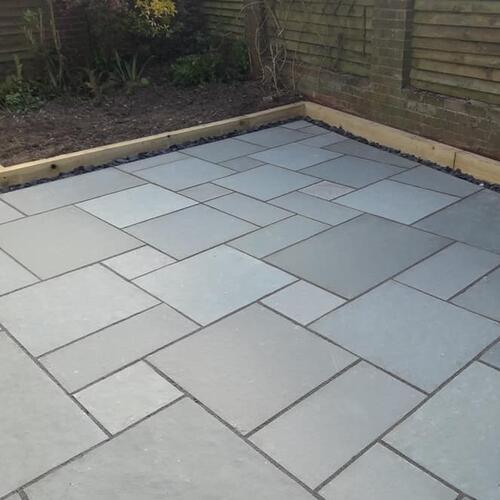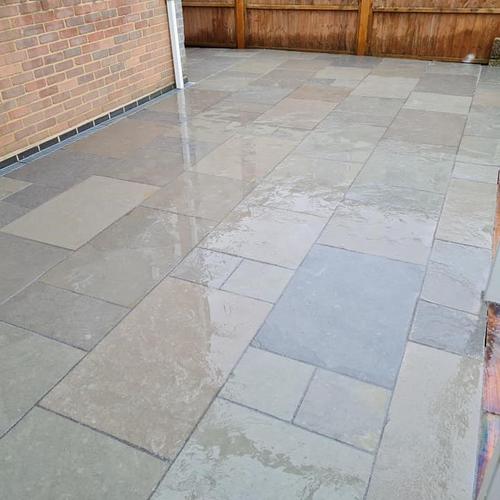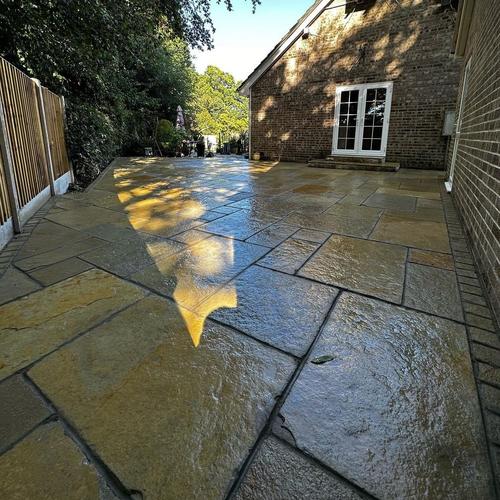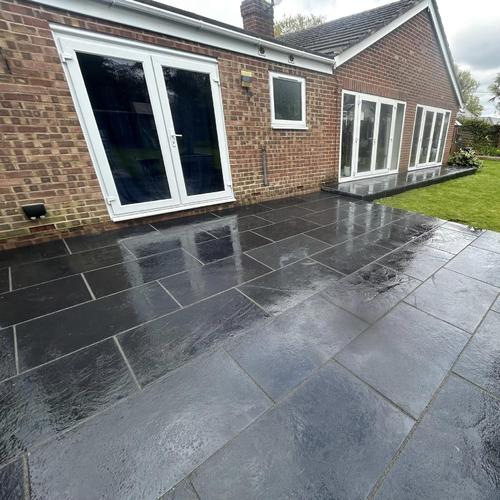Limestone Paving Range
Limestone Paving Range
Here at Stone Zone, we offer a fantastic range of natural, Indian Limestone Paving; perfect for creating a rustic, natural look for your outdoor space.
To highlight our Limestone Paving range, we have created this handy guide so you can browse our products in one place.
Furthermore, to make your life a little easier, we have also taken the initiative to explain how to maintain your Limestone patio so you can reap the benefits of your paving for as many years as possible.
Stone Zone Limestone Collection
Aqua Kota Limestone
Also available in Weathered and Square Edge (22mm Calibrated)
Click HERE to Purchase
Dove Great Square Edge Limestone (22mm Calibrated)
Click HERE to Purchase
Citron Yellow Limestone
Also available in Weathered and Square Edge (22mm Calibrated)
Click HERE to Purchase
Carbon Black Limestone
Also available in Weathered, Square Edge (22mm Calibrated) and as Circle Kits
Click HERE to Purchase
Limestone Paving in Your Garden
Patios
- Outdoor Entertaining Areas: Limestone paving is ideal for creating elegant and durable patios where people can gather, dine, and relax.
- Terraces: Use limestone to construct terraced levels in a garden, providing both beauty and practicality.
Pathways
- Garden Paths: Create charming walkways through gardens and yards, offering a natural look that blends well with greenery.
- Driveways: Limestone paving can be used for driveways, offering a sturdy and attractive surface that can withstand heavy vehicles.
Pool Surrounds
- Pool Decking: Limestone's non-slip properties make it an excellent choice for pool areas, providing a safe and cool surface to walk on.
- Water Features: Enhance the look of fountains, ponds, and other water features with limestone paving.
Steps and Staircases
- Garden Steps: Construct steps that seamlessly integrate into the landscape design.
- Entrance Steps: Use limestone for grand entrance steps to homes or buildings, adding a touch of elegance.
Outdoor Seating Areas
- Benches and Seats: Create built-in seating areas using limestone, which are both functional and aesthetically pleasing.
- Fire Pits and BBQ Areas: Design seating around fire pits or BBQs using limestone for a cohesive outdoor living space.
Courtyards
- Private Courtyards: Utilize limestone to pave secluded courtyard areas, providing a serene and stylish retreat.
- Commercial Spaces: Limestone can be used in commercial courtyards for a professional and inviting look.
Border Edging
- Garden Beds: Use limestone paving to edge garden beds, keeping plants contained and creating neat lines.
- Lawn Edges: Define the boundary between lawns and other areas with limestone borders.
Indoor Applications
- Interior Flooring: Limestone paving can be used indoors for a seamless transition between indoor and outdoor spaces.
- Conservatories: Pave conservatories with limestone to create a natural, light-filled environment.
Public Spaces
- Parks and Gardens: Limestone paving is often used in public parks and gardens for pathways, seating areas, and decorative features.
- Town Squares and Plazas: It provides a durable and attractive surface for heavily trafficked public areas.
Accent Features
- Decorative Insets: Create intricate designs and patterns within larger paved areas using contrasting colours or sizes of limestone.
- Mosaics and Art: Incorporate limestone into mosaic designs or as part of outdoor art installations.
What is the Difference Between Limestone and Sandstone Paving?
Limestone and sandstone are both popular choices for paving, each offering unique characteristics that make them suitable for different applications and aesthetic preferences. Here's a detailed comparison of the two:
Composition and Formation
Limestone:
- Composition: Primarily composed of calcium carbonate (CaCO₃).
- Formation: Formed from the accumulation of organic materials, such as shells and coral, over millions of years.
Sandstone:
- Composition: Made of sand-sized mineral particles, primarily quartz and feldspar.
- Formation: Formed from the compression of sand deposits over time.
Appearance:
Limestone:
- Color Range: Typically available in shades of white, beige, grey, and blue.
- Texture: Generally has a fine-grained, smooth texture.
- Variations: Tends to have a more uniform appearance with fewer visible grains.
Sandstone:
- Color Range: Offers a wider range of colors including shades of yellow, red, brown, and tan.
- Texture: Has a rougher, more granular texture due to its sand composition.
- Variations: Often shows a more varied and layered appearance with visible grains and striations.
Durability and Hardness
Limestone:
- Durability: Generally softer and more prone to scratching and weathering compared to sandstone.
- Hardness: Lower on the Mohs hardness scale, typically around 3-4.
Sandstone:
- Durability: More resistant to wear and weathering, making it suitable for high-traffic areas.
- Hardness: Higher on the Mohs hardness scale, usually around 6-7.
Maintenance
Limestone:
- Care: Requires regular sealing to prevent staining and weathering.
- Cleaning: Can be sensitive to acidic cleaners; mild soap and water are recommended.
Sandstone:
- Care: Less frequent sealing is needed but still recommended for longevity.
- Cleaning: Generally more tolerant of various cleaners but mild, non-acidic solutions are best.
Slip Resistance
Limestone:
- Surface: When wet, limestone can become slippery, especially if polished.
- Finishes: Opt for honed or tumbled finishes for better slip resistance.
Sandstone:
- Surface: Typically provides better slip resistance due to its rougher texture.
- Finishes: Naturally non-slip, making it ideal for wet areas like around pools.
Weather Resistance
Limestone:
- Climate Suitability: Performs well in temperate climates but can be susceptible to damage in freezing conditions.
- Weathering: Can develop a patina over time, which may be desirable or undesirable depending on the look you want.
Sandstone:
- Climate Suitability: Suitable for a wider range of climates, including extreme temperatures.
- Weathering: Generally more resistant to frost and heat.
Cost
Limestone:
- Price Range: Can be more expensive due to its more uniform and refined appearance.
Sandstone:
- Price Range: Often more affordable, especially for large areas.
Applications
Limestone:
- Ideal Uses: Patios, pathways, indoor flooring, and wall cladding.
- Aesthetic Appeal: Preferred for its clean, elegant look and uniformity.
Sandstone:
- Ideal Uses: Garden paths, driveways, pool surrounds, and outdoor seating areas.
- Aesthetic Appeal: Favored for its natural, rustic look and variety of colours.





